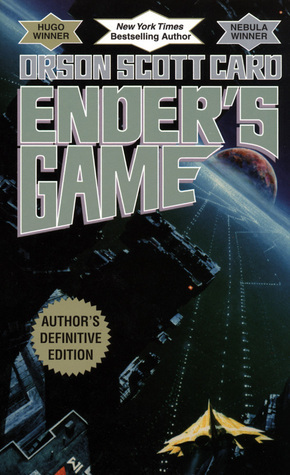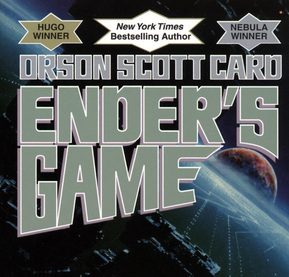As I was writing last week’s post about white room dialogue, I kept thinking about Ender’s Game, by Orson Scott Card—a book which famously (and thoroughly) breaks the rule about white room dialogue. So since my last post about a dialogue rule was followed by an example of breaking the rule, I thought I’d follow that trend here.
I first heard the juxtaposition between Ender’s Game and the white room dialogue rule several years ago on Writing Excuses[1], and I will rely on what those excellent podcasters said about it. I distinctly remember author Mary Robinette Kowal talking about Card breaking this rule—serendipitously in their episode entitled “Breaking the Rules”. They talked about the costs and benefits of breaking established writing rules, and Ender’s Game was one of their examples.
White Room Dialogue in Ender’s Game
Every chapter in Ender’s Game starts with several lines of unattributed dialogue—which means that the book itself starts off with white room dialogue. What this does is immediately add a touch of intrigue to the book. Who are these mysterious people, and who are they talking about? The second question gets answered pretty quickly in the rest of the first chapter, and the other question is answered slowly throughout the course of the book. But those reader questions set the tone of the whole novel.
By not providing dialogue tags or any context for the conversation, Card immediately showed the reader that what was important in this conversation was the subject, not the speakers. He used these conversations to show (instead of tell) that the speakers are mysterious and shadowy. You get the sense, without being told, that some sort of underhanded government organization is involved (especially with later references to political leaders and conversations being recorded)[2].
Now, this was done at the cost of reader disorientation and possible confusion. But the benefit was that readers’ curiosity was also instantly piqued. The cost and the benefit are directly correlated. So Card made the conscious decision to break a rule in order to achieve his greater themes for the book. And because the white room segments are kept short, the cost is minimized. The first one in particular is only half a page, so the reader is quickly reassured that the whole book won’t be written this way. The disorientation is settled within a few short lines, while the curiosity is still there. And since these white room exchanges open each chapter, it is clear they are a feature rather than a mistake.
Beyond the White Room
What I found particularly interesting was that, even as the story continues in less of a white room, the book is remarkably dialogue heavy. The majority of the writing is dialogue. And a fair portion of the non-dialogue writing consists of Ender’s thoughts, which could be considered dialogue in their own way. Card’s dialogue tags are sparse. He actually uses a fair number of said bookisms, though well below the threshold of annoying and overwrought.
That being said, all of this heavy dialogue is still not happening in a white room (other than the chapter openings, of course). Card uses the dialogue to describe the scene. Right after the first white room that opens the book, a nice and smiling woman tells a young boy “it won’t hurt a bit” and “just sit right up here on the examining table. The doctor will be in to see you in a moment.” We know, without any scene description, that Ender is in a doctor’s office.
And though he doesn’t describe the physical scene in great detail, Card still does an excellent job of pacing and avoiding dialogue fatigue by filling in the blanks between bits of conversation with Ender’s thoughts on the whole situation. We get insights into Ender’s character as well as the setting and plot. All while keeping the pace appropriate to the speed of the action.
Pacing in Dialogue
 As I noted in last week’s post, the key to balance between dialogue and description is pacing. By the third page (in my 1991 paperback edition), Card has already used the exception I noted for when to give in to the white room just a bit—i.e. in a tense situation. After describing Ender’s pain during an operation, we get this exchange:
As I noted in last week’s post, the key to balance between dialogue and description is pacing. By the third page (in my 1991 paperback edition), Card has already used the exception I noted for when to give in to the white room just a bit—i.e. in a tense situation. After describing Ender’s pain during an operation, we get this exchange:
“Deedee!” shouted the doctor. “I need you!” The nurse ran in, gasped. “Got to relax these muscles. Get it to me, now! What are you waiting for!”
Something changed hands; Ender could not see. He lurched to one side and fell off the examining table. “Catch him!” cried the nurse.
“Just hold him steady—”
“You hold him, doctor, he’s too strong for me—”
“Not the whole thing! You’ll stop his heart—”
Ender felt a needle enter his back just above the neck of his shirt. It burned, but wherever in him the fire spread, his muscles gradually unclenched. Now he could cry for the fear and pain of it.
“Are you alright, Andrew?” the nurse asked.
As the situation intensifies, Card uses fewer and fewer dialogue tags and descriptive words. And then when Ender is given the medication and things calm down, the non-dialogue returns. You may have also noticed that Card used two simple said bookisms to good effect (“shouted” and “cried”). The situation was dramatic, so the dramatic dialogue tags are called for—but he still doesn’t go overboard with them.
Weighing Costs
As I alluded to in my post on Robert Asprin breaking dialogue rules (and quite possibly this is something that should be its own whole blog post), the key to breaking rules is to do it consciously. You need to understand why the rule exists, and what cost you will pay for breaking it.
In this case, the cost of white room dialogue is reader disorientation. Card determined that cost was worth paying in order to achieve the tone he was looking for. He also accepted the cost of using the occasional said bookism in order to heighten the drama in certain scenes. And in a way, he accepted the “cost” of writing a dialogue heavy book (i.e. potentially losing interest of people who need more description in their novels) because the benefit was a novel that places its emphasis on interpersonal relationships and the character development of one particular person. All of which thrives on dialogue.
Don’t be afraid to break rules in your writing. Just be aware of the costs.
[1] If you read my blog a lot, you’ll find I’m a huge fan of this podcast. I firmly believe every author-in-training (which is every author) should listen and learn from Writing Excuses.
[2] This fits perfectly with the exception TV Tropes notes in their entry on the Featureless Plane of Disembodied Dialogue—namely that “an author may do this on purpose, for example to keep The Omniscient Council of Vagueness appropriately vague.”


Pingback: 2022 Reading Diary Part 2! – Peter's Site!